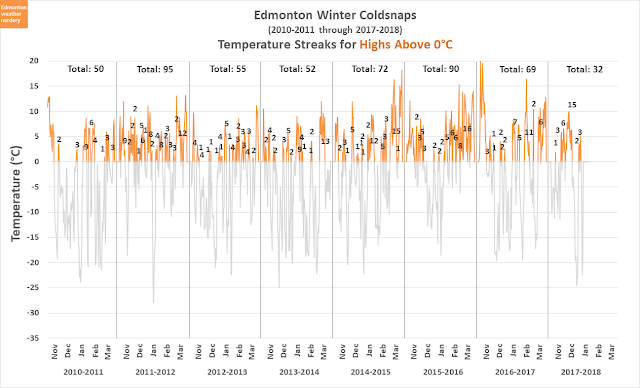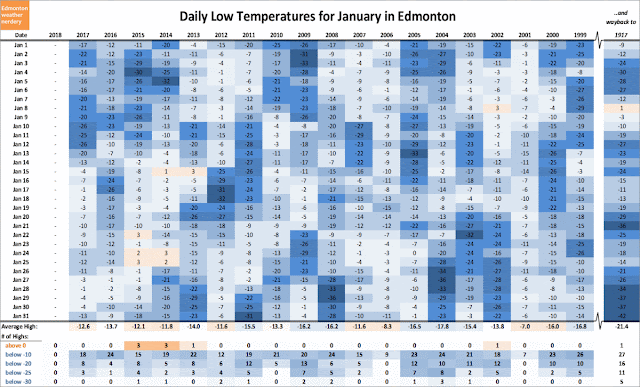High Temperatures
Here are the high temperatures for January, and we started off warm, got cold, got warm again, and then got cold again.
We didn't set any records this month - either all time or recent - but on the 18th we did hit 8.6°C which was very close to the all-time record of 9.0°C from 2009. We looked at that heatwave in detail in Record Watch - January 17, 18 & 19.
I like to tell people that January always gets some warm days, and in the last 20 years the average has been 11 days with Highs above 0°C. This year we were just a bit below that with 10, and that included 4 Highs above 5°C.
We also had 3 Highs below -20°C, and the last time that we had that many cold Highs was in 2012.
Overall though, the average High for January 2018 was -4.3°C, and that's just a touch warmer than the 20-year average of -4.8°C.
Low Temperatures
Here we have the Low temperatures, with the familiar rollercoaster. We set a recent-coldest (since 1996) Low on New Year's Day, at -27.6°C, and then a recent-warmest Low on January 19th at -1.9°C.
The average Low for the month was -14.3°C. which was just a touch below the 20-Year average Low of -13.7°C.
The deepfreezes felt like they lasted forever, but honestly we were right about where we would expect to be. We had 9 Lows below -20°C including 3 below -25°C, and that's about as typical as it gets for January.
Warm and Cold Months
This chart could use some explanation, and for that it's probably easiest to go back to How Warm is 2017 - the Months. Generally though, it's showing how the average temperature for each month compares to the average for the 20th century, and also to the average for the last 5 years.
January was about 4°C warmer than the 20th century average for January's. But recent January's have all been pretty warm - the 5-Year average is 5.3°C above the 20th century. So January 2018 was warmer than history, but a little bit cooler than the last few years.
As this chart cycles through the years January 2001 really stands out, at 10.8°C above the 20th century average. If we look back to the temperature tables for earlier, we can see that that January had 25 Highs above 0°C, and the coldest Low was only -15°C,
Monthly Snow
January was pretty snowless, right up until the storm we got on the 25th, 26th and 27th. Those 3 days totalled 11.8cm, and that brought our total for the month to 15.1cm. That's a bit below the average of 21cm, but a bit above the 12cm that we got in January last year.
Cumulative Snow
For the winter so far, January brings our cumulative snow total to 60.5cm. That's just about where we were at this time last year, and below the average of 80cm.
Snowdepth
Here we have the snowdepths measured at the International Airport going back to 1995. We'd been pretty low so far this winter, although the storm at the end of the month bumped us up to about 18cm.
It's been a few years since we've had a really snow winter - 2010-2011, 2012-2013 and 2013-2014 all reached the 44cm-52cm range. We looked at that in more detail in Snowdepth - Part 2 - The Big Melt.
And here we can see how the snowdepths at the International and Blatchford compare to the average. The recent snowstorm pushed both stations up to around the average. Earlier in the month though, the International had been at 8cm while Blatchford was at 2cm.
In the past I've been suspicious of Blatchford's snowdepth measurements. We see an example of that here, because Blatchford jumped from 1cm of snow on the ground all the way up to 24cm, even though we only got about 12cm of snow during the storm. In comparison the International jumped from 8cm to 18cm, which is more reasonable. For these snow measurements I've always used the International as the main reference, and I will continue to do that.
This chart also shows the snowdepth last year, and it saw significant melting in both January and February.
February
And finally, here we have the recent history of February temperatures.
February is a lot like January, with usually 10-15 Highs above 0, and 5 Lows below -20°C. It's also on-average the least-snowy of the main winter months.



















































